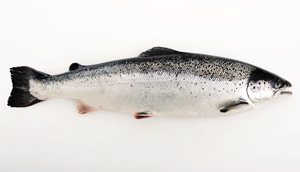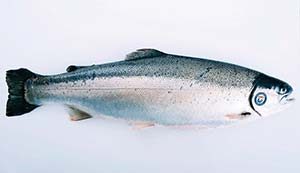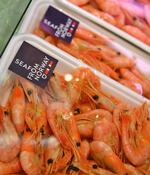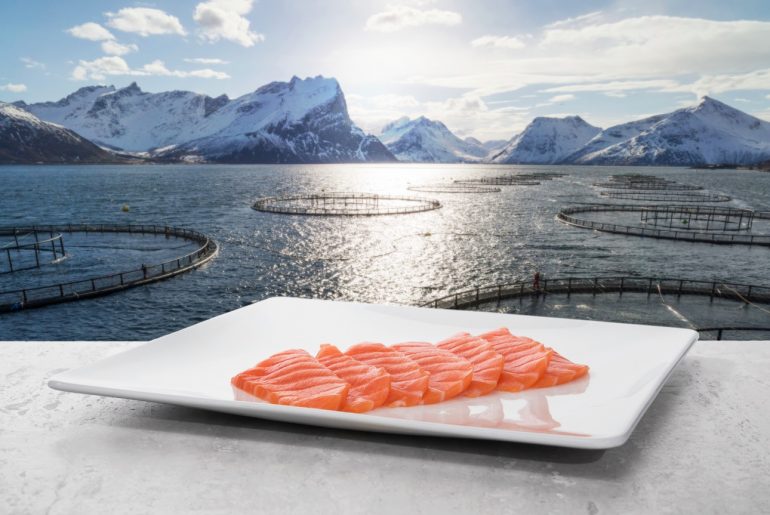Norway exported 207,000 tons of seafood totaling NOK 9.8 billion in January. Volume is at the same level as last year, while export value increased by NOK 1.2 billion, or up 15 per cent, compared with January 2019.
“The Norwegian seafood year starts with a historically high level of January exports. Demand for salmon is increasing in all regions, and average prices are considerably higher than in the same period last year. For whitefish, increased volumes and prices are contributing to growth in value. We have also seen an increase in value for trout, herring and mackerel. At the same time, a weak Norwegian kroner against all the important currencies is another explanation for the growth in value,” says Tom-Jørgen Gangsø, director of market insight and market access at the Norwegian Seafood Council.
Huge Value Growth for Salmon Exports
Approximately 88,000 tons of salmon were exported with a value of NOK 6.8 billion in January. This is an increase in volume of 3 per cent, while the value rose by NOK 1.2 billion, or 21 per cent, compared with January 2019.
The average price for whole salmon in January was NOK 75.86 per kg, compared to NOK 62.44 per kg in January last year. Poland, France and Denmark were the largest buying countries.

“Demand for salmon rose sharply in January. There is strong growth in value for all regions, with a 22 per cent increase in value to the EU, 20 per cent to Asia and 23 per cent to North America. In volume terms, there is a slight decline of 3 per cent to Asia. We see this decline primarily in relation to the shift in Chinese New Year compared to last year,” said Paul T. Aandahl, seafood analyst at the Norwegian Seafood Council.
“Most of the fresh salmon to China is consumed through HoReCa. And since residents are encouraged to stay home (due to the deadly novel coronavirus now wreaking havoc in the PRC), the demand from restaurants will change. A possible effect with limited outdoor activities could be a turning towards increased home consumption, said Victoria Braathen, with the Norwegian Seafood Council’s operations in China.
Large Growth for Trout Exports
In January, 5,700 tons of trout were exported with a value of NOK 356 million. Export volume increased by 45 per cent, while value increased by NOK 94 million, or 36 per cent, compared with January last year. Ukraine, the United States and Thailand were the largest trout market sin January.

“The biggest growth market for trout exports last month was Ukraine, with a huge 259 per cent increase. Despite the Russian market being closed to Norwegian salmon via Belarus in January, the reduction to this market was only 13 per cent or 67 tons”, said Paul T. Aandahl.
Great Start for Skrei Exports
Approximately 6,100 tons of fresh cod were exported, including skrei with a value of NOK 328 million. This is an increase in the volume of 32 per cent, while export value increased by NOK 103 million or 46 per cent compared to January 2019. Denmark, the Netherlands and Poland are the largest recipients of fresh cod in January.
“Traditionally, January starts with a rise in prices of fresh cod, both for fishermen and in the markets. There is a high demand for cod, which begins in January, before catches get started, so triggering price growth. As catches increase during the season, prices normally fall, which we are already seeing in signals from the markets. Over the past five years, the export price of fresh whole cod has fallen by 18 to 30 per cent from January to February,” said Ingrid Kristine Pettersen, a seafood analyst at the Norwegian Seafood Council.
Decline in Frozen Cod Exports
In January, 5,100 tons of frozen cod were exported at a value of NOK 231 million. This is a 48 per cent reduction in volume, while the value fell by NOK 162 million, or 41 per cent. The UK, China and Poland were the largest buyers of frozen cod during the first month of the year.
“The reduction in export of frozen cod is mainly due to reduced landings of frozen raw material,” explained Pettersen.

Stable Export Value for Clipfish
Roughly 8,600 tons of clipfish worth NOK 408 million were exported. Volume fell by 8 per cent, while value remained unchanged from January last year. Brazil, Portugal and the Dominican Republic were the most important markets in January.
“Price is still the main value driver for clipfish. Volumes fell for the two largest species, saithe and cod – saithe in particular. In January, Brazil purchased 50 per cent of all clipfish from Norway and in doing so was the largest market. The Brazilian currency has weakened in recent years, to a greater extent than the Norwegian kroner’s falls in the past year, and this trend will continue into 2020. This means that inflation is higher in the Brazilian currency than it is in the Norwegian kroner, which affects demand”, said Øystein Valanes, the Norwegian Seafood Council’s fishing envoy to Brazil.
Herring and Mackerel Sales Strong
About 34,300 tons of herring were exported, fetching NOK 332 million in January. The volume is at the same level as last year, while receipts increased by NOK 47 million or 17 per cent. Poland, Lithuania and Germany were the main markets.
In January, 26,500 tons of mackerel worth NOK 439 million were exported. Volume increased by 17 per cent, while value increased by NOK 68 million, or 18 per cent. Countries buying the most were South Korea, China and Japan.
Large Reduction in Prawn Exports
Approximately 921 tons of prawns were exported at a value of NOK 75 million. This is a 50 per cent reduction in volume, while the value fell by NOK 35 million, or 32 per cent, from January last year. Sweden, the United Kingdom and Finland were the largest markets.
“The drop in volume is due to reduced raw prawns exports, while frozen peeled prawns exports are at the same level as in previous years. The export of raw prawns varies greatly and depends, among other things, on catch conditions. Reduced export of raw prawns also explains the increase in the average price”, says Frank Isaksen, chief analyst at the Norwegian Seafood Council.

King Crab Exports Up
Exports of 233 tons of king crab were generated NOK 76 million in receipts. This represents a 2 per cent reduction in volume, but an increase in export value of NOK 6 million, or 9 per cent. South Korea, the United States and Japan were the largest destinations for Norwegian king crab in January.





